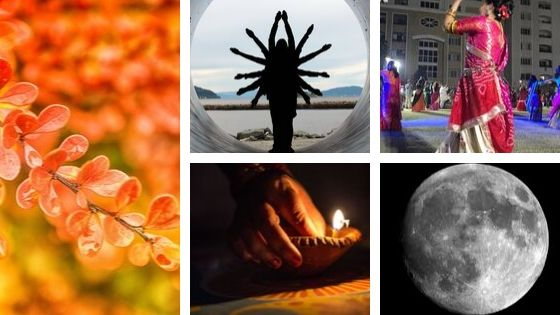Our elders bless us profoundly and passionately saying “Shatam (One Hundred) Jivem (Live) Sharadam (Autumn)”…May you live to be a hundred-years-old…and with good health.
Sharad ritu or the Autumn season makes its onset in the Northern hemisphere during September, soon after the monsoon gets over. It is then that dark clouds disappear, and the sun rays start soaking Mother Earth. In this season mornings are extremely warm whereas evenings and night are quite cool.
The variation between these two extreme temperatures give rise to and helps spread airborne diseases (viral as well as bacterial). Harsh sun rays aggravate body’s pitta (fire) which governs our digestion and metabolism. Due to this, the acid and bile becomes excessive thereby lowering our immunity. It is no surprise then that onset of Autumn season is the time when people catch a lot of infection.
Surprisingly and fortunately the solution of these problems is very well intertwined with all the rituals of our festivals.
Pitrupaksh literally meaning ‘fortnight of the ancestors’ is a 16–lunar day period in Hindu calendar when Hindus pay homage to their ancestor (Pitrs), especially through food offerings. During this period, we offer rice kheer, ghee laddu and other sweets to our Pitrs and eat it as a prasad. These balance the pitta dosha or the acid levels of our body.
After that comes the vibrant festival of Navratri, or Nine nights – the festival of divinity, prosperity, and energy. A large number of people in India fast during these nine days/ or on select days or eat sattvic (pure) food. The foods in this diet not only exemplify the principle of Ahimsa (non-violence) but are also natural, essential, energy-containing and clean. This diet helps balance hormones and increases immunity.
Fasting food like sabudana (sago), sama rice (or samo rice / samak rice / jungle rice), rajgira (literally meaning God’s grain or Royal grain or Amaranth), fruits and milk provide vital nutrients to our mind and body.
During Navratri people light Akhand (unbroken) ghee lamp which not only invites the divine to come and bless us but also helps clean the impurities in the surrounding air.
In the western parts of India, Navratri is celebrated in the form of a dance known as garba. Garba, which is derived from the word Garbha (womb), is performed in a large circle which represents life like a foetus in the mother’s womb. Garba is performed by clapping hands on traditional Navratri music at night. The soft and cool light of the moon provides calmness to mind and body and the synchronized sound of claps generates vibrant energy that helps to clean the Auras.
The claps hold tremendous power in literal sense as well. There are around thirty acupressure points both hands. While clapping these points energize and enhance blood supply to all the organs. This boosts our immune system, reduces our stress and anxiety levels and the Urja (energy) of the claps lowers the blood cholesterol levels as well.
Similarly, Bathukamma (Mother Goddess come alive) is a floral festival celebrated in Telangana and some parts of Andhra Pradesh for these nine days. Flowers are worshipped to celebrate our bond with nature. These flowers are arranged into a dome shaped stacks (also known as bathukammas), which include seasonal flowers which have medicinal value as well . Women clap rhythmically around these bathukammas making a gentle circular movement.
Dandiya (stick) raas in Gujarat and Kolattam (stick dance) in southern India are performed using sticks where the sticks provide the rhythm.
Akin to this is the Dhunachi (incense burner) nritya (dance)in eastern part of India which is accompanied with the rhythmic beats of dhak (membranophone instrument). The dance is performed to appease Goddess Durga.
During this period, northern parts of India witness Jagran (to awaken) or Jagrata (remaining awake at night) – a practice to invoke Vaishno Devi. It involves singing, clapping and dancing to rhythmic songs, thereby dispersing energy all around.
Sharad Purnima (full-moon) which falls on a full-moon night, is the time when the moon is closest to the earth and its rays are supposed to possess nourishing properties. The prasad of kheer orpuffed rice is kept under these rays and consumed later as it absorbs the curative properties of the rays.
Sharad is the time for introspection, seeking wisdom, detoxifying your body and energizing your mind. The powerful rituals purify our mind, body, heart and soul – all at once. So, soak in the festivities and stay healthy in every possible dimension.

















No Comments
Leave a comment Cancel